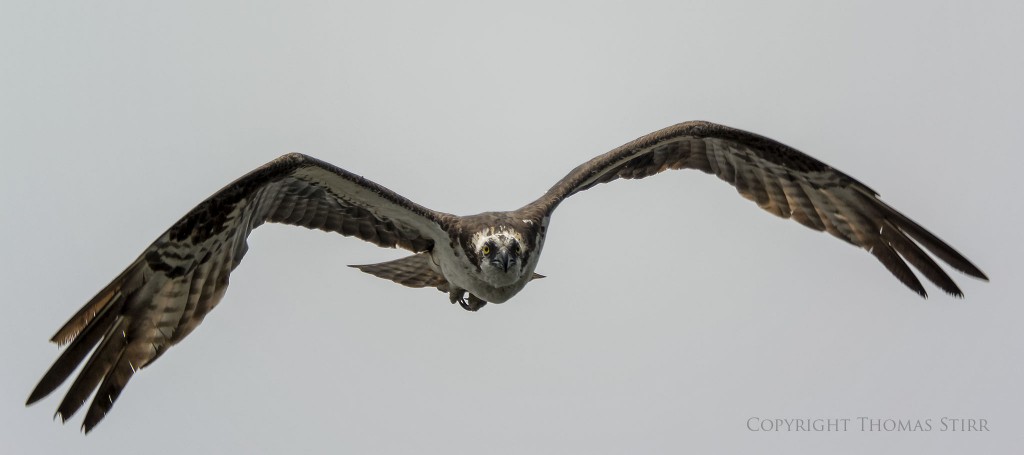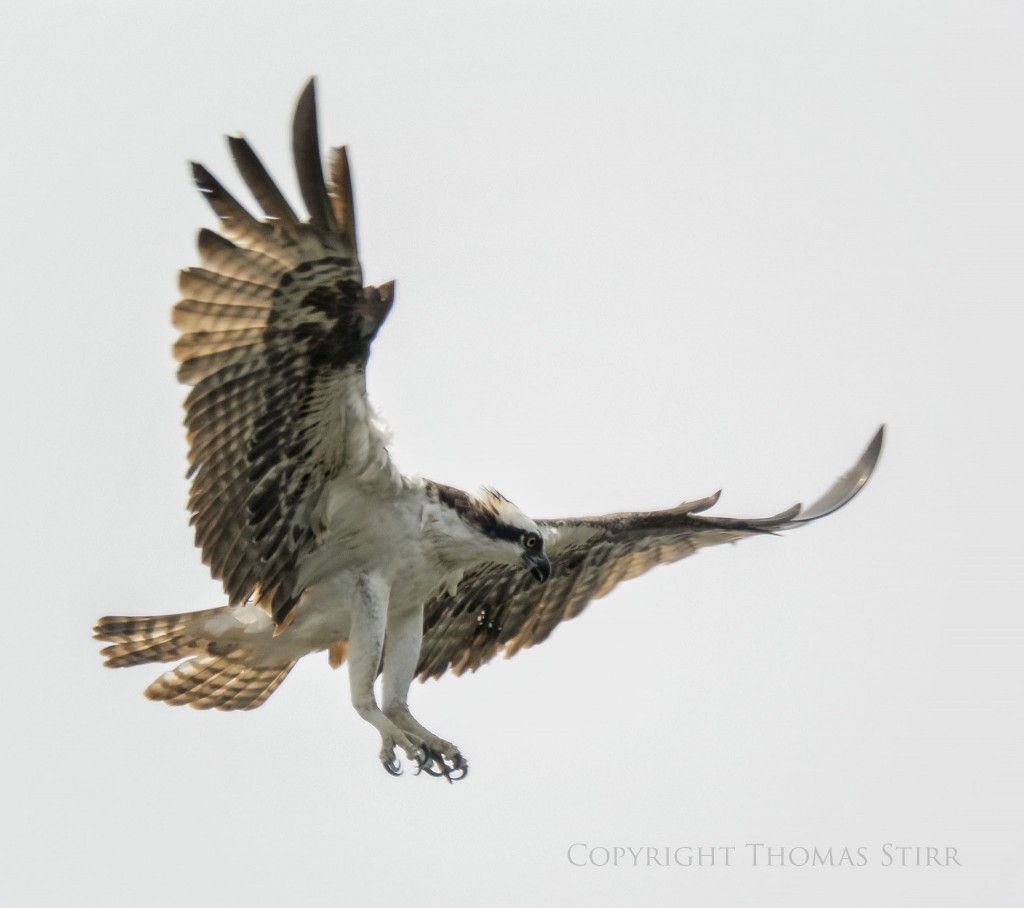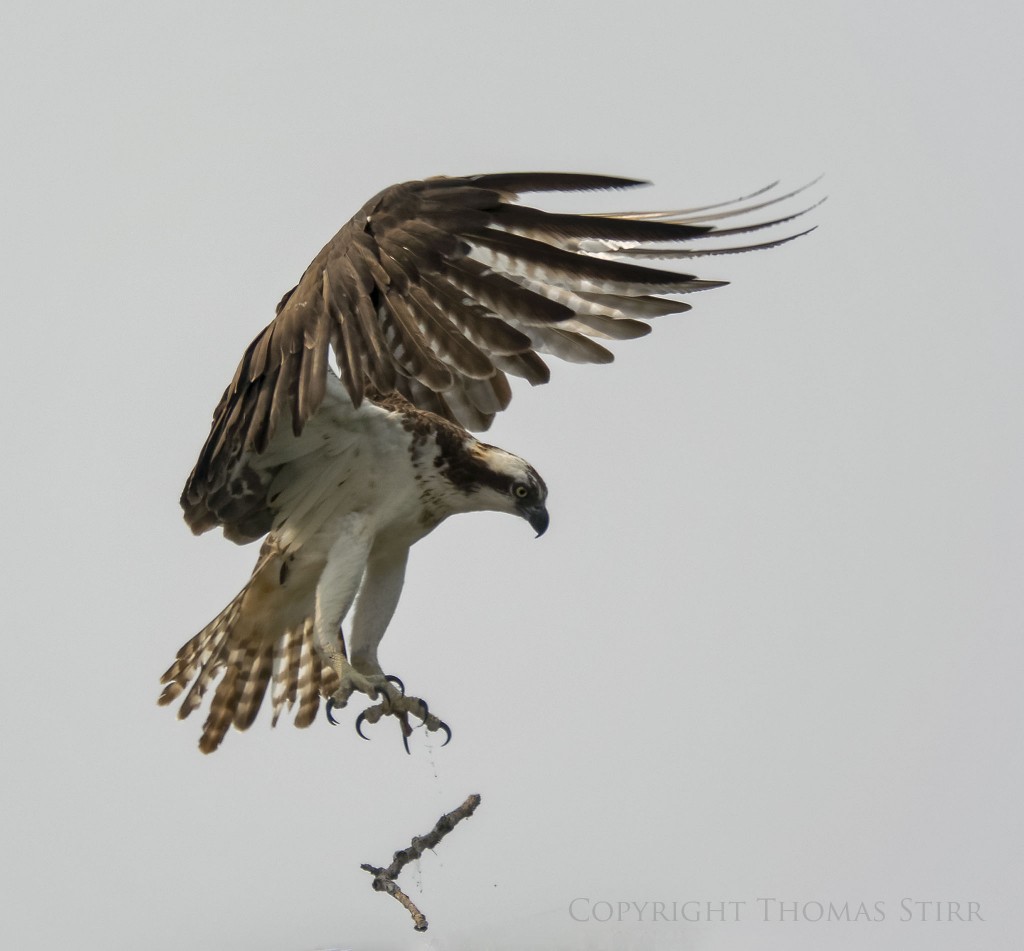Both professional and amateur bird photographers often have their favourite subjects – and many have a special affinity for birds of prey. I was extremely fortunate to capture a range of images of osprey in flight during a recent morning visit to Mountsberg Conservation Area, near Campbellville Ontario.
NOTE: Click on images to enlarge.

I have visited this facility about a half dozen times over the past number of months and only once did I even catch a glimpse of an osprey that was actually close enough to photograph. By the time I got my camera out of my bag it had vanished.
As everyone who takes photographs of birds in flight knows, the opportunities we are afforded to capture images are often few and far between.

Each time I visit Mountsberg Conservation I visit the Raptor Centre and view the various birds on display. And, being an optimist, I also trek out to the observation blind at the reservoir.

There is a nesting box out over the water that can be observed from the blind. The last time I visited Mountsberg it had been commandeered by some Canada geese which defended it vigorously every time an osprey ventured anywhere close by.

Not wanting to miss any opportunities during this trip to Mountsberg, I prepared my Nikon 1 V2 in advance of visiting the blind, using manual settings and auto ISO.

I set my aperture at f/5.6 and used a shutter speed of either 1/1250 or 1/1600. Since the blind is a fair distance from the nesting box all of my images in this article were shot with my CX 70-300 mm f/4.5-5.6 fully extended.

I used AF-C with subject tracking and set my Nikon 1 V2 for 15 fps. Based on past experience I figured that I wouldn’t have that many chances to capture these magnificent birds in flight and I wanted to get as many frames as possible.

Since the lighting was quite bright I wanted to try to ensure good exposures on potential subject birds so I set my V2’s metering for centre weighted.

I also turned the VR off with the in-camera setting of my Nikon 1 V2. This was to help ensure the maximum number of images with the birds fully captured in each frame.

As expected, the number of opportunities to capture osprey in flight was quite limited. Total viewing time was less than 5 minutes spread out over a couple of hours. During each brief osprey encounter my V2 dutifully acquired AF-C and rattled off images at 15 fps. As a result I was able to get just over 400 images of osprey in flight during my morning visit.

As luck would have it, the birds were in the process of nest building and I was able to get some images of osprey carrying twigs to the nesting box. Overall, it was an enjoyable morning and I was able to get a number of usable images.
The more I use my Nikon 1 V2 with the Nikon 1 CX 70-300 lens for birds in flight, the more confident I have become with this gear, It has now become my preferred birding set-up. I love the lightweight and easy portability, as well as the effective AF-C performance. When needed, shooting at 15 fps is simply fantastic!
Technical Note: All images in this article were captured hand-held using a Nikon 1 V2 with a Nikon 1 CX 70-300 f/4.5-5.6 VR lens. Images were created from RAW files processed through DxO OpticsPro 10 including PRIME noise reduction. A DNG file was then exported to CS6 and Nik Suite for additional adjustments as required.
My intent is to keep this photography blog advertising free. If you enjoyed this article and/or my website and would like to make a modest $10 donation through PayPal to support my work it would be most appreciated. You can use the Donate button below. Larger donations can be made to tom@tomstirr.com through PayPal.
Article and images Copyright Thomas Stirr. All rights reserved. No use, duplication of any kind, or adaptation is allowed without written consent.


Hi Thomas and the other Nikon 1 expos. compensation posters,
Thank you very much for your detailed answer(s), comment(s) and advice.
Now I definitely know that I have to do without exposure compensation when photographing wildlife in manual mode/Auto ISO my 1V2.
I really appreciate that function with my FX bodies, with them expos. comp. varies ISO. (If only they were lighter and smaller).
For me that is the fastest way of reacting to exposure problems. (You never have enough time when photographing fast moving animals).
Kind regards
Joachim
addition:
…… in manual mode/Auto ISO WITH my 1V2…..
You’re welcome Joachim!
Tom
When all else fails, look at the manual. On page 182, Exposure Compensation is Unchecked under the “M” setting. It is checked for Auto, P, S and A. The section starts on page 181 of my manual, and is titled “Available Settings”. Personally I have never used (mostly because I shoot mainly in M mode).
WEJ
Hi William,
It would appear that there are different versions of the V2 owner’s manual. I checked all three Nikon 1 V2 manuals that came with my cameras and none of them even have exposure compensation listed in the index. And, all of my manuals are only 102 pages long. Of course in Canada our gear is supplied with separate French and English manuals which may be why we have different versions.
Tom
I was afraid that different manuals might have different lengths, which is why I also mentioned the section I found this in (Available Settings). I have not tried downloading the English manual lately, but if still available I would suggest doing that also, and go through the section.
I normally open the PDF file, and then use the Find function to look up terms. I find this process easier then using the index (plus it also finds all references to words or phrases).
WEJ
Hi William,
That is a great tip – thanks for sharing it! I’ll make a point to go on the Nikon USA site to download their version of the V2 manual. From your comment it appears to have a lot more information in it than does the manual that came with my V2.
Tom
Hi Tom:
I was very glad to see you were able to get many excellent photos of the Ospreys at Mountsberg. I was concerned that the Canada Geese had taken away any opportunity for nest building by the Ospeys who were the original occupants of the nest. Thanks for your persistence to re-visit the site again and have the opportunity to obtain these images.
Hi Ray,
Thanks for the positive comment – I’m glad you enjoyed the images! I remember that it was a bit disheartening to see the Canada geese had taken over that nest the last time you and I did some shooting together at Mountsberg.
Tom
Thomas — Poster Joachim raises an interesting question. I, too, shoot my Nikon 1 in Manual Mode and Auto-ISO and that’s ordinarily ideal for me. But I’ve yet to find a way to enable Exposure Compensation with those settings. Occasionally, it would be nice to nudge the exposure a bit one way or the other, without auto-ISO compensating (for example, a dark bird against a bright sky). Is there a way to do it?
Hi David,
I just replied to Joachim so you can see my more detailed response in that posting. In terms of getting different exposures of birds in flight the only thing that I find gives me some options is switching from matrix, centre weighted, and spot metering.
Tom
Thanks so much for the reply — and it confirms my suspicion that exposure comp is not possible when shooting in manual mode and auto-ISO. But, as you point out, it’s really not necessary if one employs the appropriate metering system for the desired result. I also agree that most of my V3/100-300mm exposures are very forgiving and can be optimized in post. I will say, though, that my very best results are at 160 ISO, as would be expected. At low ISOs, V3 image files are astonishingly good, in my opinion. That CX sensor will not displace my full-frame Sony’s but I confess that it regularly amazes and is great fun to shoot. By the way, it goes without saying that your Osprey shots are excellent. Here is a link to my best of that species but they were shot with a Sony A7II and Tamron 150-600mm lens — before I had the V3 — https://www.davidscottimages.com/?p=1162.
Hi David,
Thanks for sharing your images – nice stuff indeed! One of the things that I continually like about the Nikon 1 V2 is its simplicity. I appreciate that the camera has quite a few limitations compared to a full frame body like your Sony A7II or my D800 in terms of settings etc…but there is something to be said for how ‘liberating’ that simplicity can be. I never fret much about the settings since they are quite basic…I just focus in on composition and getting the most I can out of that little, CX sensor. I guess its limitations force me to be a bit more creative when I use it. I view my D800 as more of a ‘fail safe’ camera…a great all rounder with a ton of dynamic range, colour depth and quite good lower light performance so it can handle pretty much anything I throw at it.
Tom
Thank you for the kind words and I totally agree that the Nikon 1 series is liberating — in many ways. It was your superb bird work with the Nikon 1 and 70-300mm lens, along with the experiences of several birding friends, that ultimately caused me to acquire the combo and I’ve used them virtually every day since acquisition. I’m hoping that if a V4 is forthcoming, its viewfinder and handgrip, both now add-ons, will be built in. I look forward to your future posts.
Hi David,
I’m with you in hoping that the future V4 has an integrated EVF and grip! Based on the specs of the J5 I think the V4 will still use micro-SD cards…that will still be a bit of a pain but as long as we get the integrated grip and
EVF I think many owners would be willing to put up with micro-SD. I’m also hoping that we will not be forced to buy yet another 10-30 lens with the V4 body.
Tom
Good Morning Thomas Stirr!
Your superb shots immediately reminded me of my really poor attempts to photograph ospreys in the Osprey Village Boat of Garten in the UK in the 80ies, (Kodachrome 64, not enough focal length, nervous).
For more than half a year now, (since YOU put me on the Nikon 1 track), I’ve been using my 1V2, also trying to shoot BIF with it, (2.8/70-200).
With FX cameras for BIF I normally use manual setting of aperture and shutter speed combined with Auto ISO, in case of bright sky as a background dialling in + exposure compensation.
With my 1V2 I somehow can’t dial in any exp. compensation with the above described settings.
Please tell me, do I miss/overlook a certain setting or does the 1V2 in manual mode with auto ISO not allow exposure compensation to be dialled in? (Or is it because the 2.8/70-200 is not a native Nikon 1 lens, whereas the CX 70-300 allows compensation with the described settings)?
Best regards from Germany
Joachim Lentz (an old chap struggling with new equipment)
Go to Flicker find Brandon Birder and ask him, he uses Nikon 1V3 with great results.
Hi Ernesto,
Brandon Birder does fantastic work and his site is absolutely worth checking out.
Tom
Hi Joachim,
Thank you for your very positive comment – I’m glad you enjoyed the article!
In terms of ‘exposure compensation’ let me preface my reply by saying that you have me at a disadvantage. I virtually never use this feature with any camera with which I shoot. I guess I’m an ‘old school’ guy and a holdover from the film days so I just rely on the ‘exposure triangle’. If exposures with my stills need some adjustment, I do it in post. I’ve shot over 80,000 still images with my V2’s and only used ‘exposure compensation’ a couple of times in the past when trying a few HDR test images.
Since I don’t really use the ‘exposure compensation’ feature I thought your question was an excellent one so I played with one of my V2’s this morning. What I found was that when shooting in Manual mode with auto-ISO the ‘exposure compensation’ function does not appear to be able to be activated. Nor could I get it to work when I pre-set the ISO to a particular value e.g. ISO-400.
The ‘exposure compensation’ function can be activated when shooting in aperture priority or shutter priority when shooting stills. However, it seems to have the same challenge when shooting with these settings as it does when doing video. I discovered when shooting video that when dialling in some ‘exposure compensation’ all that really happens is that the camera adjusts either the aperture or shutter – it does not ‘lock in’ the original camera settings and does not appear to actually tweak how it is metering the scene. I suspect this is why Nikon 1 cameras do not offer auto bracketing.
I looked back at some images where I did some HDR exposures and discovered that while my aperture was constant (I had shot in aperture priority mode) all that a +3 or -3 exposure compensation did was change my shutter speed accordingly.
If there are other Nikon 1 users who have used ‘exposure compensation’ extensively perhaps they can share their experiences. I kept a log of my settings when playing around this morning and every time I was able to activate the ‘exposure compensation’ function and used it…it changed either my aperture or shutter speed.
Rather than use exposure compensation I tend to switch between matrix, centre weighted and spot metering. For landscapes I will often meter in centre weighted and use single point AF to see how I can get differing exposures of the same scene.
Not sure if this has helped you or not…
Tom